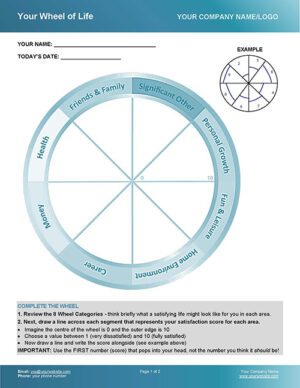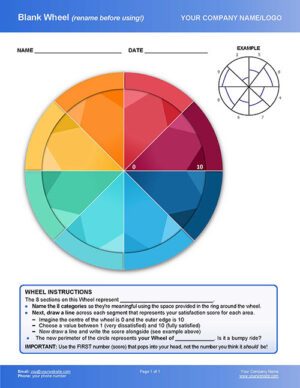Originally Posted on The Coaching Tools Company as How to use a Life Wheel to Measure Your Client's Coaching Progress | 5 Simple Steps
What’s in this Guide to using the Life Wheel to Measure Progress
This article will take you through the steps to measure a client’s progress using the life wheel. Below you will find:
Why measure your clients’ progress at all?
It’s always important for coaches to keep track of and remind clients what they’ve achieved—the steps and progress they’ve made on the journey towards their goals.
But there are a number of specific reasons we might want to monitor and measure our client’s progress while they coach with us.
Here are my top 3 reasons:
- We want our clients to feel satisfied (or thrilled!) with our coaching.
- Coaching is a big financial investment for our clients. So demonstrating tangible progress helps our clients feel great about the money they’re spending with you.
- Lastly, when our clients feel they’ve spent wisely hiring us, they:
- work harder
- tell other people and give us referrals
- stay coaching with us longer
- and are happier—and that’s a win-win-win-win-win!
So in this article we’ll look at how, by measuring and scoring a life wheel at intervals during your coaching relationship, you can show your clients they’re making solid progress.
Why use a Life Wheel to Measure Coaching Progress?
Whatever kind of coaching you do or niche you have, we all coach the whole person.
So whether you’re a life, executive, retirement or couples coach, each client needs to find their own version of balance in life to be happy and at their best.
The Life Wheel is great for intangible goals
Often our clients have intangible or hard to measure goals like be more content with my life, have more confidence, be less stressed or lighten up and have more fun.
In these cases, scoring a life wheel is a perfect way to create a measure for how they are doing—and feeling. Sometimes the life wheel scores can even be the specific “Measurable” clients use in their SMART Coaching Goals.
How often should you do a Life Wheel review?
My preferred process is to use the exact same worksheet over the course of a year (re-scoring at 3 month periods) to review and track progress.
Because while a monthly review can be enough to see some progress, I find a progress review every 3 months or so is the most effective. This gives the client time to make more progress, and it works wonderfully to create a virtuous circle that keeps the client motivated, on track and moving forwards.
Get your Free Life Wheels here:
-
 Individual Tool
Individual ToolWheel of Life Template with Instructions
Don’t reinvent the wheel—use this wheel of life template instead! Our most popular free coaching tool has been downloaded over 350,000 times (and counting)! Read More…
Also Available In: Coaching Welcome Packet
Learn More
Free!
-
 Individual Tool
Individual Tool*UPDATED* BLANK Coaching Wheel
One of our most popular coaching exercises, this blank wheel of life is a powerful, fully customizable free coaching tool! Read More…
Also Available In: Life Coaching Toolkit
Learn More
Free!
How to use a Life Wheel to Track & Measure Coaching Progress
Simply follow the process below using The Wheel of Life Template, a Blank Wheel on any topic, or the Brighten Up Your Life Exercise (a customised life wheel, exclusive to our popular Renew You, Love Your Life Coaching Program).
STEP 1) Create a baseline
Begin by scoring a coaching wheel with your coachee. You can use a customised blank wheel or a pre-categorised life wheel, then simply ask your coachee to complete the wheel, scoring each of the segments as you would normally.
If you’ve already done a life wheel with your client, great—you already have your baseline!
And if not, why not give it as homework? Then this becomes the baseline you’ll compare future scores against.
STEP 2) Wait 3 months
- In 3 months’ time (or another time period of your choosing depending on the client and how things are going), begin one of your coaching sessions with a progress review.
- First, ask permission from your client (ideally at the end of the previous coaching session). Then let your coachee know you’d love to have a quick check-in and see what progress they’ve made.
Now you can simply skip straight to Step 3). Or if you’d like to be a bit more thorough, allow an extra 10 mins and complete the OPTIONAL Step below.
OPTIONAL STEP) Hold a Goals Progress ReviewOptionally, you might like a more thorough check-in with your client around their goal progress. If so, ask some questions like the below to see how your clients are getting on with their goals:
Click here for more on How Do You Measure Progress Towards Goals? |
STEP 3) Re-score each element of the Wheel with your client
Top Tip: Re-use the same wheel worksheet your client completed last time, simply using a different pen colour to write today’s date and note down their updated scores. Then use a different pen colour at each subsequent review.
- So, whatever kind of wheel you started with (customised blank wheel or life wheel) your client, ask your client to complete their wheel again, scoring each of the segments for how they feel now.
STEP 4) Discuss and compare how the scores have changed
- Review each segment in turn, sharing with your client (or point out) the previous or initial score they gave to each area.
- Note whether their satisfaction score went up or down. Ask whether they are surprised by any of the scores?
Note: In my experience there was ALWAYS an improvement, even if it was only one point! And if there wasn’t, something unexpected had came up in their lives like losing a job, loved one etc.
STEP 5) Reflect and Learn
Lastly, coach the client and help them reflect on and establish learnings: what changed and why. Ask questions to go deeper like:
- For each area on the life wheel: Why do you think this score has changed? What are you doing differently?
- What has changed in your life generally?
- How have you changed?
- What have you learned about life and yourself since we last scored your life wheel?
- Where specifically has our coaching been helpful in improving these scores?
Wrap-up
While we may informally discuss ‘progress’ at each coaching session, an explicit progress review is a powerful tool that should be in every coach’s toolbox.
And this process is super simple and effective; whenever I’ve done a life wheel review with my clients, they have always been surprised and pleased by the progress they’ve made.
Because with the exception of those big ‘Aha’ moments, changes in our clients’ lives are generally slow and steady. Most people don’t realise how far they’ve come because they’re so focused on everything they still have to do.
Which makes this life wheel review a powerful process to demonstrate the power of (your) coaching!









